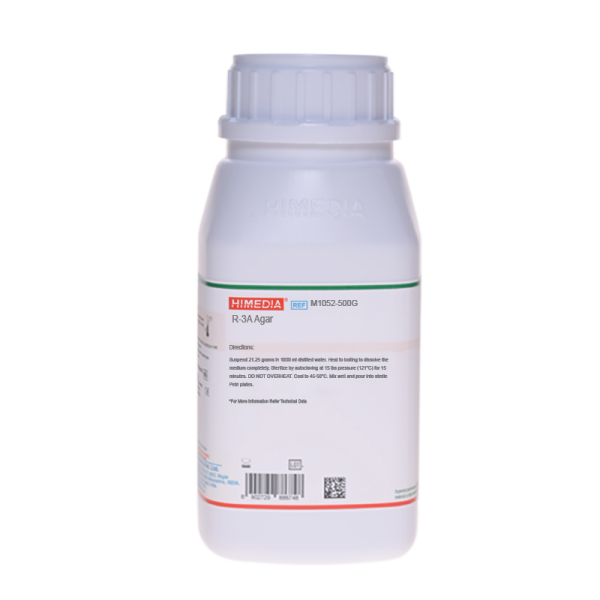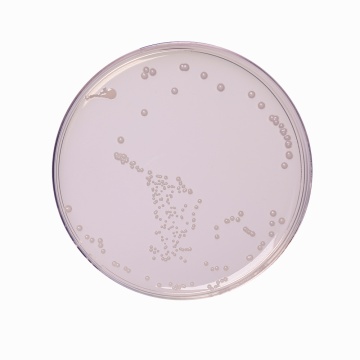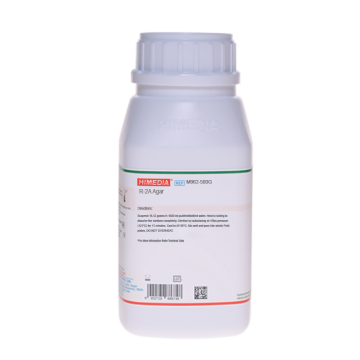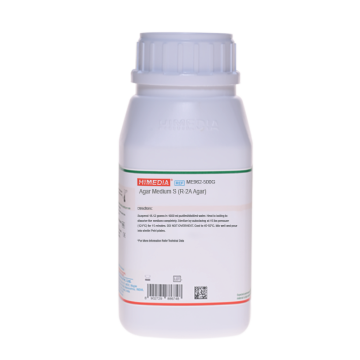 Your enquiry has been submitted
Your enquiry has been submitted
R-3A Agar
R-3A Agar is used for subculturing microorganisms recovered on less nutritive R-2A Agar from potable water samples.
Composition**
| Ingredients | Gms / Litre |
|---|---|
| Casein acid hydrolysate | 1.000 |
| Yeast extract | 1.000 |
| Biopeptone | 1.000 |
| Dextrose | 1.000 |
| Starch, soluble | 1.000 |
| Dipotassium phosphate | 0.600 |
| Magnesium sulphate | 0.048 |
| Sodium pyruvate | 0.600 |
| Agar | 15.000 |
Final pH (at 25°C): 7.2±0.2
**Formula adjusted, standardized to suit performance parameters
Directions
Suspend 21.25 grams in 1000 ml distilled water. Heat to boiling to dissolve the medium completely. Sterilize by autoclaving at 15 lbs pressure (121°C) for 15 minutes. DO NOT OVERHEAT. Mix well and pour into sterile Petri plates.
Principle And Interpretation
R-2A Agar is recommended by APHA (1, 2) for estimating the heterotrophic plate count by the pour plate, spread plate or membrane filter procedure. R-2A Agar is formulated as per Reasoner and Geldreich (3). Stressed or injured organisms during water treatment are unable to grow on high nutrient media, since the faster growing organisms outgrow the former (4). Therefore the use of a low nutrient medium like R-2A Agar incubated for longer incubation periods allows these stressed organisms to grow well.
R-3A Agar is slightly more nutritious than R-2A Agar and is used for subculturing the isolates obtained on the less nutritive R-2A Agar (5).
Biopeptone, casein acid hydrolysate and yeast extract provide nitrogen, vitamins, amino acids, carbon and minerals. Dextrose serves as an energy source. Soluble starch aids in the recovery of injured organisms by absorbing toxic metabolic byproducts while sodium pyruvate increases the recovery of stressed cells. Magnesium sulphate is a source of divalent cations and sulphate. Dipotassium phosphate is used to balance the pH of the medium.
Quality Control
Appearance: Cream to yellow homogeneous free flowing powder
Gelling: Firm, comparable with 1.5% Agar gel
Colour and Clarity of prepared medium: Light yellow coloured clear to slightly opalescent gel forms in Petri plates
Reaction: Reaction of 2.13% w/v aqueous solution at 25°C. pH: 7.2±0.2
pH: 7.00-7.40
Cultural Response
M1052: Cultural characteristics observed *by using standard ATCC cultures after an incubation at 35-37°C for 24-72 hours. (*-In case of water samples from fields it is suggested to incubate further for upto 7 days to ascertain the absence of organisms)
| Organism | Inoculum (CFU) | Growth | Recovery |
|---|---|---|---|
| Candida albicans ATCC 10231 | 50-100 | good-luxuriant | >=50% |
| Enterococcus faecalis ATCC 29212 | 50-100 | good-luxuriant | >=50% |
| Escherichia coli ATCC 25922 | 50-100 | good-luxuriant | >=50% |
| Salmonella Enteritidis ATCC 13076 | 50-100 | good-luxuriant | >=50% |
| Salmonella Typhi ATCC 6539 | 50-100 | good-luxuriant | >=50% |
Storage and Shelf Life
Store below 30°C in tightly closed container and the prepared medium at 2-8°C. Use before expiry date on the label.
Reference
- Clesceri L. S., Greenberg A. E. and Eaton A. D., (Ed.), 1998, Standard Methods for the Examination of Water and Wastewater, 20th Ed., American Public Health Association, Washington, D.C.
- Downes F. P. and Ito K., (Eds.), Compendium of Methods for the Microbiological Examination of Foods, 4th Ed., American Public Health Association, Washington, D.C.
- Reasoner D. J. and Geldreich E. E., 1985, Appl. Environ. Microbiol., 49:1.
- Collins V. J. and Willoughby J. G., 1962, Arch. Microbiol., 43:294.
- Atlas R. M., 2004, Handbook of Microbiological Media, Lawrence C. Parks, (Ed.), 3rd Edition, CRC Press.
| Product Name | R-3A Agar |
|---|---|
| SKU | M1052 |
| Product Type | Regular |
| Physical Form | Powder |
| Origin | Animal |
| Packaging type | HDPE |
| References | 1. Clesceri L. S., Greenberg A. E. and Eaton A. D., (Ed.), 1998, Standard Methods for the Examination of Water andWastewater, 20th Ed., American Public Health Association, Washington, D.C. |
| Customized Product Available | No |










